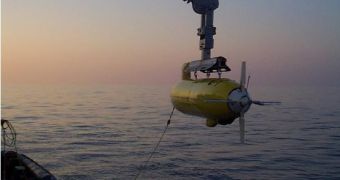Hybrid technology strikes again! No, not in the automobile industry, this time it reached onto ocean-going submersibles. The Woods Hole Oceanographic Institution, famous for finding the wreck of the RMS Titanic near Newfoundland back in 1985, with the help of an Argo submersible, has just invented a new robotic glider that runs on energy absorbed from the sea. According to WHOI, this capability gives its new vehicle an autonomy wider than any other submersible powered through electric energy drawn from batteries.
Multiple tests have already concluded that the new submersible design can stay underwater, for periods of time at least two times longer than previous submersibles. Thermal energy is harnessed from the ocean, as the vehicle moves from areas with colder water towards warmer regions of the ocean. During this time, tubes filled with wax suffer an expansion, which pressurizes gas in a second tank that can be used to power pneumatic motors.
Physical oceanographer Ben Hodges, from WHOI, says that, during tests, the new submersible was capable of covering a distance more than 20 times larger than the distance between the islands of St. Thomas and St. Croix, of the U.S. Virgin Islands. With such energy efficiency it could eventually be deployed for study in missions as long as one to two years, unlike the powered submersibles thar can only last for periods of time up to six months long.
Further still, the vehicle ensures its own buoyancy, by pumping oil into bladders placed on its sides, meaning that is capable of modifying its volume without suffering a change in mass. Steering is ensured by a vertical rudder, probably the only feature still remnant from the battery-powered submersibles. Hodges says that the only electrical energy required is to power the on-board electronic instruments and to operate the rudder control, and the vehicles will probably be used in future long-duration underwater expeditions to save funding money.

 14 DAY TRIAL //
14 DAY TRIAL //